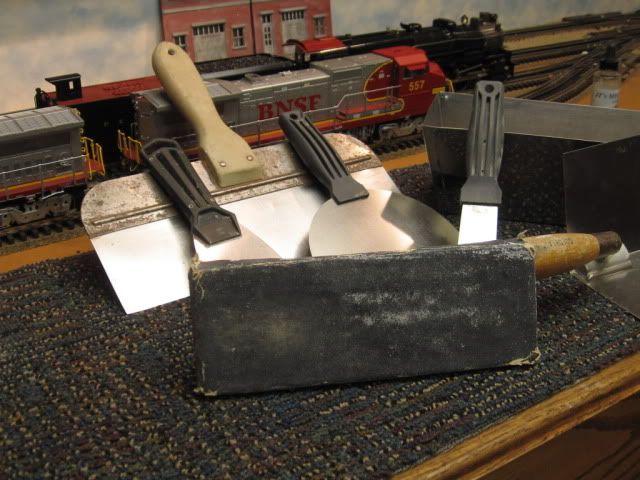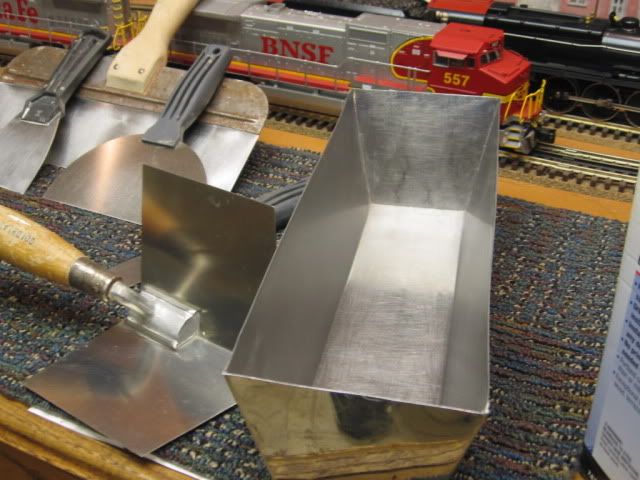I am working a a large water scene with docks and I made the land scape out of plaster paper covered insulation foam. I painted it and every time I touch it the plaster crumbles I know I have to rip it up and start over but is their a better material to use? Also what did I do wrong to have the plaster be so brittle? Thanks in advance you guys ae always the best.
Replies sorted oldest to newest
It’s been many years since I’ve done scenery. I laid plaster soaked brown grocery bags over a cardboard web. I know when adding layers or building up the surface you must soak the previously laid towels with water from a spray bottle. The dry plaster absorbs the water from what you are trying to put on and it will react as you described. Always apply the plaster to a wet surface and keep it damp till it sets. It should dry rock hard and have a warm ness to it when it sets.
just put lightweight joint compound over the Styrofoam. Spray Paint when still wet then put on grass like and ground like and other materials. LET dry for 2-4 days.
Drywall compound in most cases is designed for a thin application. 1/4" to 1/8". There are quick set compounds, usually have to be mixed, with water, that can be used to fill larger areas. Available from model train suppliers, one of our forum sponsors, I think??, Hydrocal. A light weight compound that I thought worked well. The Hydrocal link posted has an additional link to a U-tube video tutorial.
Link to Scenic Express catalog download. At one time there were paper catalogs, probably hard to find. The catalog, a victim of the digital age. IMO.
You may have to invest in some basic drywall/plaster tools.


Have fun ![]()
![]()
![]()
No Tools... just my hands in gloves.
Jolodo,
Also consider using Sculpt-a-mold. I generally speaking, use it before adding plaster. I will be using foam, then plaster cloth, and finally sculp-a-mold when I begin my waterfront. Some skip using plaster cloth and just put the sculpt-a-mold directly on the foam. I probably will not use plaster at all for this project. Let us know what you decide and the results.
Dave
Lightweight joint compound is available at Menards (Ring-Ring) and Home Depot etc. Get a small container or two.
After you secure the chunks of Styrofoam with Great Stuff in a rough shape of what you want; Then HAND apply the LWJC over the Styrofoam. Do worry about the details just lob it on. Then using the "Di Vinci Method" spray paint while wet and toss on a lot of grass/earth mixture. I use a aerosol spray to get the grass mix on the entire thing.
Later you can spray adhesive and add even more grass/earth mix or spray paint more light earth tone colors or plunk down trees or big rocks. Knock your sox off! but not on the mountains!
I sometimes spray a bit of black on it and then a light sprays of silver or gold paint to give it a reflective quality.
A) 3/4" to 2" thick rigid foam, cut and stacked to the rough shape of what you're making.
B) Great Stuff non-expanding spray foam to smooth out the edges and contours.
C) Woodland Scenics plaster sheets dipped in water and laid over the structure (buy a cheap, disposal aluminum baking pan of the correct size for the sheets at your grocery store).
D) When dry, apply earth tone paint(s) and sprinkle various colored and textured turfs while paint is still wet.
E) When dry, spray with cheap hairspray to keep the turf in place.
Plaster that cracks usually means it either wasn't supported right or it dried to fast IME. Plaster if it is under any kind of tension will crack, it may not like if you just put the plaster on the foam. I would either use plaster soaked bags or other kinds of paper (if you can get old gauze bandage cheaply, that works great too), and use that as a base. If it is really warm where you are working, spritzing it with water can get it to cure slower (the same technique is used with concrete to make it cure slower and prevent cracking). Once that sets, you could then use plaster to create more of a landscape, and again while that is curing spritz it to slow down the curing.
Thank you everyone for your help. I am still contemplating what to do. I was wondering if I apply a coat of polyurethane would that protect the plaster from damage and how would the realistic water react to it? Thanks again,
Joe
@Jolodo posted:I am working a a large water scene with docks and I made the land scape out of plaster paper covered insulation foam. I painted it and every time I touch it the plaster crumbles I know I have to rip it up and start over but is their a better material to use? Also what did I do wrong to have the plaster be so brittle? Thanks in advance you guys ae always the best.
Something very wrong with the plaster.
Too many over think this stuff. Keeping it simple succeeds. Start with a fresh bag of Hydrocal. Or you can waste time and more money using other stuff that makes work.
You can apply Hydrocal directly over foam insulation; mix up a bit at a time in a plastic bowl and literally just paint it over the terrain with an old brush that you will throw away later. You don't need a thick layer either. Could also apply Hydrocal directly over a woven terrain of cardboard or even just brown paper bags - something somewhat heavier in weight that just newsprint. When done, clean the brush. Pop the plastic bowl clear. Repeat as needed to do more scenery.
I was told when I started my landscaping years ago. To always buy plaster that was fresh. Doubt they have expiration dates on the bag. But best to buy from a supplier that has a good turnover in product. If you know someone in the trade ask them where they go. I used 50 pound bags of what was called Special White. I believe the mix was 2 parts plaster to 1 part water. You had about a 20 minute work time. The plaster in the bag should have a very powdery feel. Not clumpy. The reason for buying fresh I was told that over time moisture can effect it and it won’t mix well or cure properly. Many bags often times have slight tears in them. After you open the bag. It’s best to store it in a container. The scenery sources have a good product. But if your doing a large layout it can get expensive. I want to say I used about 4 bags on my layout. The end result. You can drill it for trees and after 30 years I’ve had no issues with it.
Not good at mixing so the ready made LWJC works better for me.
Attachments
I’ve always used dowmans fix-it-all. I’ve never had it crack and I like the way it can be carved just before it sets up.




